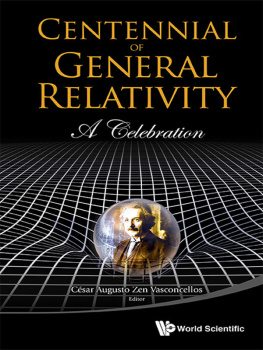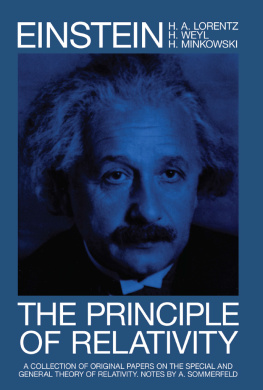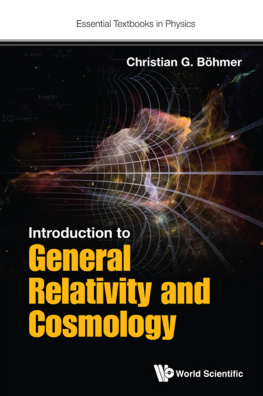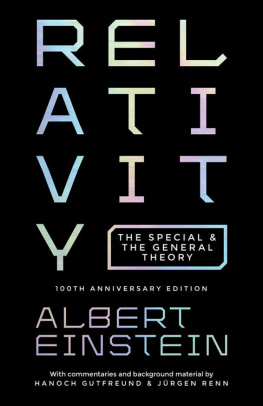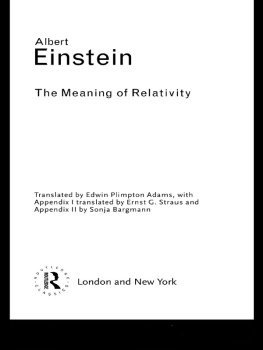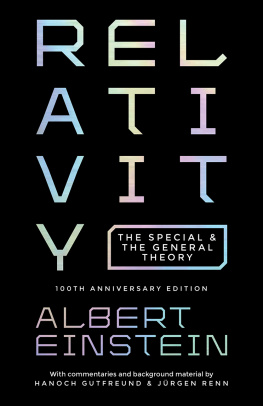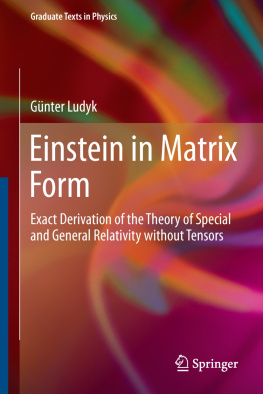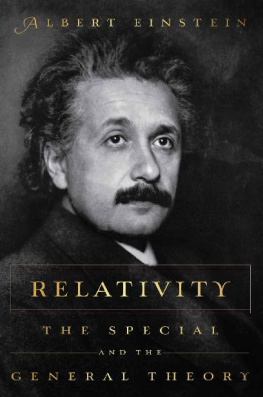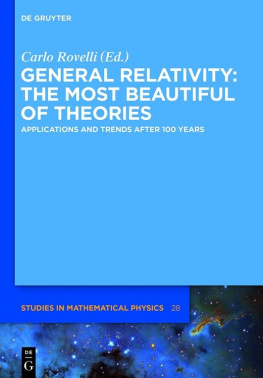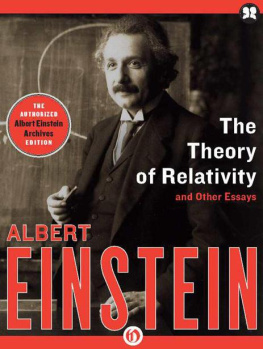C ENTENNIAL
OF
G ENERAL
R ELATIVITY
A Celebration
CENTENNIAL
OF
GENERAL
RELATIVITY
A Celebration
Editor
Csar Augusto Zen Vasconcellos
Universidade Federal do Rio Grande do Sul, Brazil & ICRANet, Italy

Published by
World Scientific Publishing Co. Pte. Ltd.
5 Toh Tuck Link, Singapore 596224
USA office: 27 Warren Street, Suite 401-402, Hackensack, NJ 07601
UK office: 57 Shelton Street, Covent Garden, London WC2H 9HE
Library of Congress Cataloging-in-Publication Data
Names: Vasconcellos, Csar A. Z., editor.
Title: Centennial of general relativity : a celebration / edited by: Csar Augusto Zen Vasconcellos (Universidade Federal do Rio Grande do Sul, Brazil & ICRANet, Italy).
Description: Singapore ; Hackensack, NJ : World Scientific Publishing Co. Pte. Ltd., [2016] | Includes bibliographical references.
Identifiers: LCCN 2016022165| ISBN 9789814699655 (hardcover ; alk. paper) | ISBN 9814699659 (hardcover ; alk. paper)
Subjects: LCSH: General relativity (Physics)--History. | Relativity (Physics)--History.
Classification: LCC QC173.6 .C46 2016 | DDC 530.11--dc23
LC record available at https://lccn.loc.gov/2016022165
British Library Cataloguing-in-Publication Data
A catalogue record for this book is available from the British Library.
Copyright 2017 by World Scientific Publishing Co. Pte. Ltd.
All rights reserved. This book, or parts thereof, may not be reproduced in any form or by any means, electronic or mechanical, including photocopying, recording or any information storage and retrieval system now known or to be invented, without written permission from the publisher.
For photocopying of material in this volume, please pay a copying fee through the Copyright Clearance Center, Inc., 222 Rosewood Drive, Danvers, MA 01923, USA. In this case permission to photocopy is not required from the publisher.
Desk Editor: Ng Kah Fee
Typeset by Stallion Press
Email:
Printed in Singapore
To my wife Mnica, to my daughter Helena, to my son Marcio, to my stepdaughters Daniela, Marina and Barbara, and to Fiorella, with love.
Preface
The equations of the General Relativity Theory (GRT) formulated by Albert Einstein in 1915,

represent the foundation of our present understanding about the universe. The right-hand side of this equation describes the energy content of the universe, where the (/8G)g term was included by Einstein in a later formulation, for cosmological reasons, which modernly is interpreted as dark energy, the cause for the current cosmic acceleration, i.e., the observation that the universe appears to be expanding at an increasing rate. The left-hand side of this equation, on the other hand describes the geometry of spacetime. The equality between these two components of the equation means that in General Relativity mass and energy determine the geometry and concomitantly the curvature of spacetime, which represents in turn a manifestation of gravity, the warping in the fabric of spacetime.
Albert Einstein in 1917 stated:
since the introduction of the special principle of relativity has been justified, every intellect which strives after generalization must feel the temptation to venture the step towards the general principle of relativity.
In a manuscript,Bruno Christoffel, Gregorio Ricci-Curbastro, Tulio Levi-Civita, and Marcel Grossmann.
Einstein was the only one however despite highlighting the brilliant contribution of the others , who had persistently followed his intuition since 1907. His brilliant intuition, combined with his persistence therefore represent the key to understand his remarkable trajectory in the development of General Relativity, a theory that has revolutionized our conceptions of the universe and our understanding of its evolution.
About the contents of the book
The first chapter of the book, by Norman K. Glendenning, is divided into two parts. The first part features with clarity and creativity, a review of the General Relativity Theory (GRT), to give insight into this remarkable theory to those readers who, from a general scientific and philosophical point of view, are interested in the most intriguing details of the mathematical apparatus and conceptions of GRT that opened a completely new perspective on the cosmos. In the second part, the author focus his attention on compact stars and into obtaining and interpreting the OppenheimerTolmanVolkoff (TOV) equations. TOV equations are essential in the understanding of the diversity of the very dense objects that comprise a substantial part of the universe mainly white dwarfs, neutron stars, pulsars, quark stars, black holes and which may provide a better understanding of the equation of state of nuclear matter and of the quarkgluon plasma, the Holy Grail of the primordial content of the universe.
In the possible astrophysical sources emitting gravitational waves which could be detected.
Einstein in the years 1945 and 1946 developed an algebraic extension of General Relativity by introducing complex-valued fields on real spacetime in order to apply Hermitian symmetry to GRT. 2016 and discuss briefly some predictions of pc-GR on this matter.
Our understanding of the origin of the universe, of its evolution and the physical laws that govern its behavior as well as the different states of matter that make up its evolutionary stage reached in recent years levels never before imagined. This is due mainly to new and recent discoveries in astronomy and relativistic astrophysics as well as to experiments on particle and nuclear physics that overcame the traditional boundaries of knowledge on physics. As a result we have presently a new understanding of the universe in its two extreme domains, the very large and the very small: the recognition of the deep connections that exist between quarks and the have also motivated Renxin Xu and Yanjun Guo to mention, in a note added in proof, that the proposed model of strange star with rigidity (i.e., strangeon star) is quite likely to be tested further by kilo-Hz gravitational wave observations.
The comprehension of the large-scale structure of the universe based on models of cold dark matter has been a major subject of study involving predictions of General Relativity and in particular inferences on dark matter from gravitational effects on visible matter. In , Roberto Sussman describes how a particular solution of the equations of General Relativity, the so-called Szekeres Models, can be used to construct assorted configurations of multiple non-spherical self-gravitating cold dark matter structures and to describe its evolution. According to the author, this approach is able to provide a fully relativistic non-perturbative coarse grained description of actually existing cosmic structure at various scales. As a consequence, this modeling allows an enormous range of potential applications to current astrophysical and cosmological problems.
The scientists view of the universe, these days, has expanded in a way never before imagined by observing, in particular, electromagnetic waves in the infrared spectrum bands, ultraviolet, radio, optical and X-rays. In this context, modern cosmology serves as a guide that covers different aspects , Marc Lachize-Rey presents a qualitative and interesting discussion about the current view of modern cosmology and the contributions of Albert Einstein and Georges Lematre on this topic. Marc Lachize-Rey discusses in his contribution, topics as diverse as galaxies and the expanding universe, big-bang models, cosmic microwave background, modern cosmology, dark issues, cosmological constant and dark energy, the topology of spacetime, and the cosmic time.

